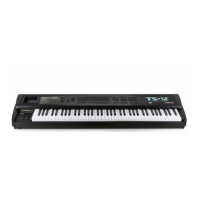Section 6 — Understanding Effects TS-12 Musician’s Manual
6
Effects Mixing
Almost all of the effects have separate mixing controls for the FX1 and FX2 busses. They are
found on the next sub-page within the Effects page, and will have slightly different wording
depending on the effect they’re contained within.
When an effect having a single processing function (such as reverb only) is selected, both busses
FX1 and FX2 are routed to it. When using a dual or multi-effect, FX1 will generally route the
signal through both or all effects, with FX2 routing only through the second effect. In all cases, a
third bus labeled DRY is a dedicated dry path to the Main Outputs.
Single Function Effect Mixer
AUX
L
R
Voice Output
Vol
L
R
Effect 1
FX1
FX2
Mix1
Mix2
Destination Bus
Main
Outputs
DRY
L
R
Aux
Outputs
Pan
The above illustration shows the effects busses and the output mixing. Every voice is assigned to
one of the four stereo busses, which go around or through the effects processing. In all of the
effects routing diagrams, the heavy lines are stereo paths.
Multiple Function Effect Mixer
AUX
L
R
Voice Output
Vol
L
R
Effect 2
FX1
FX2
Mix1
Mix2
Destination Bus
Main
Outputs
DRY
L
R
Aux
Outputs
Effect 1
Pan
When the selected algorithm is a combined effect that has more than one signal processing
function (such as chorus and reverb), the FX1 bus feeds Effect 1, and the FX2 bus feeds Effect 2.
The FX2 Mix control sets the amount of Effect 2 (usually reverb) for voices assigned to that bus.
FX1 Mix controls the amount of the output from Effect 1 sent to Effect 2 rather than directly to the
output. By setting this control to its extremes, you can arrange the two effects to be either in
series or in parallel. The majority of combined effects follow this topology. If a specific algorithm
uses a different topology, it will be explained in the Effect Parameters section.

